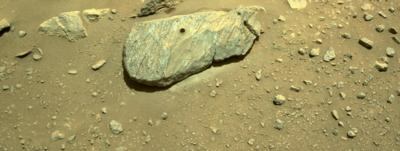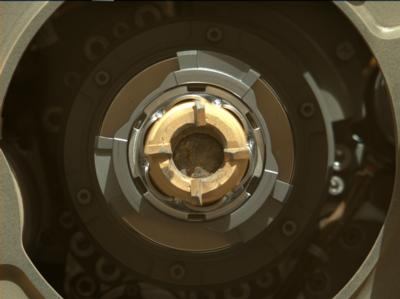“The Project Got Its First Cored Rock Under Its Belt, And That’S A Phenomenal Accomplishment...”
Data received late Sept. 1 from NASA’s Perseverance rover indicate the team has achieved its goal of successfully coring a Mars rock. The initial images downlinked after the historic event show an intact sample present in the tube after coring. However, additional images taken after the arm completed sample acquisition were inconclusive due to poor sunlight conditions. Another round of images with better lighting will be taken before the sample processing continues.

Obtaining additional imagery prior to proceeding with the sealing and storing of Mars rock sample is an extra step the team opted to include based on its experience with the rover’s sampling attempt on Aug. 5. Although the Perseverance mission team is confident that the sample is in the tube, images in optimal lighting conditions will confirm its presence.
Perseverance’s Sampling and Caching System uses a rotary-percussive drill and a hollow coring bit at the end of its 7-foot-long (2-meter-long) robotic arm to extract samples slightly thicker than a pencil. Within the bit during coring is a sample tube. After completing yesterday’s coring, Perseverance maneuvered the corer, bit, and open end of the sample tube in order to be imaged by the rover’s Mastcam-Z instrument. The target for the sample collection attempt was a briefcase-size rock belonging to a ridgeline that is more than half-a-mile (900 meters) long and contains rock outcrops and boulders.
The initial set of images from Mastcam-Z showed the end of a cored rock within the sample tube. After taking these images, the rover began a procedure called “percuss to ingest,” which vibrates the drill bit and tube for one second, five separate times. The movement is designed to clear the lip of the sample tube of any residual material. The action can also cause a sample to slide down farther into the tube. After the rover finished the percuss-to-ingest procedure, it took a second set of Mastcam-Z images. In these images, the lighting is poor, and internal portions of the sample tube are not visible.

“The project got its first cored rock under its belt, and that’s a phenomenal accomplishment,” said Jennifer Trosper, project manager at NASA’s Jet Propulsion Laboratory in Southern California. “The team determined a location, and selected and cored a viable and scientifically valuable rock. We did what we came to do. We will work through this small hiccup with the lighting conditions in the images and remain encouraged that there is sample in this tube.”
Commands uplinked to the rover will result in images of the corer and tube to be acquired tomorrow, Sept. 3, at times of day on Mars when the Sun is angled in a more favorable position. Photos will also be taken after sunset to diminish point-sources of light that can saturate an image. The photos will be returned to Earth early in the morning of Sept. 4.
If the results of this additional imaging remain inconclusive, the Perseverance team still has several options to choose from going forward, including using the Sampling and Caching System’s volume probe (located inside the rover’s chassis) as a final confirmation of the sample being in the tube.

The Sept. 1 coring is the second time that Perseverance has employed its Sampling and Caching System since landing in Jezero Crater on Feb. 18, 2021.
A key objective for Perseverance’s mission on Mars is astrobiology, including the search for signs of ancient microbial life. The rover will characterize the planet’s geology and past climate, pave the way for human exploration of the Red Planet, and be the first mission to collect and cache Martian rock and regolith.
Subsequent NASA missions, in cooperation with ESA, would send spacecraft to Mars to collect these sealed samples from the surface and return them to Earth for in-depth analysis. The Mars 2020 Perseverance mission is part of NASA’s Moon to Mars exploration approach, which includes Artemis missions to the Moon that will help prepare for human exploration of the Red Planet. JPL, which is managed for NASA by Caltech in Pasadena, California, built and manages operations of the Perseverance rover.
 Aero-TV: DeltaHawks Diesel Power Steps Into the Spotlight
Aero-TV: DeltaHawks Diesel Power Steps Into the Spotlight NTSB Prelim: Mooney Aircraft Corp. M20K
NTSB Prelim: Mooney Aircraft Corp. M20K ANN FAQ: Turn On Post Notifications
ANN FAQ: Turn On Post Notifications ANN's Daily Aero-Linx (12.20.25)
ANN's Daily Aero-Linx (12.20.25) Aero-News: Quote of the Day (12.20.25)
Aero-News: Quote of the Day (12.20.25)





